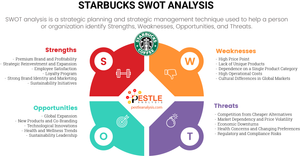Explore the strengths, weaknesses, opportunities, and threats facing the coffeehouse chain Starbucks. Get the latest insights and analysis on this global brand.
Starbucks (formally known as Starbucks Corporation) is the world’s largest coffeehouse chain. It operates over 33,000 locations globally as of 2023.
Founded in Seattle in 1971, Starbucks has grown to serve a wide array of hot and cold beverages (primarily coffee) and snacks. Recently, the company has diversified its offerings to include branded products like packaged coffee beans, coffee machines, mugs, and other gifts.
Starbucks Financial Performance Overview
Based on Starbucks' latest annual report, key financial metrics for the fiscal year ending October 1, 2023, include:
- Total Revenue: $36.4 billion, reflecting a year-over-year increase driven by strong global demand.
- Net Income: $4.6 billion, indicating robust profitability despite economic challenges.
- Operating Income: $6.1 billion, demonstrating efficient cost management and operational performance.
- Earnings per Share (EPS): $4.20, highlighting strong returns for shareholders.
- Total Number of Stores: Over 37,000, showcasing the company's ongoing global expansion.
These metrics underscore Starbucks’ strong financial performance, reinforcing its position as a leading player in the global coffee shop industry. For detailed financial performance, refer to the full report here.
Starbucks Strengths
Starbucks must be doing something right if they manage to take home billions of dollars every year, after expenses. What’s more, the profits seem to keep growing from year to year!
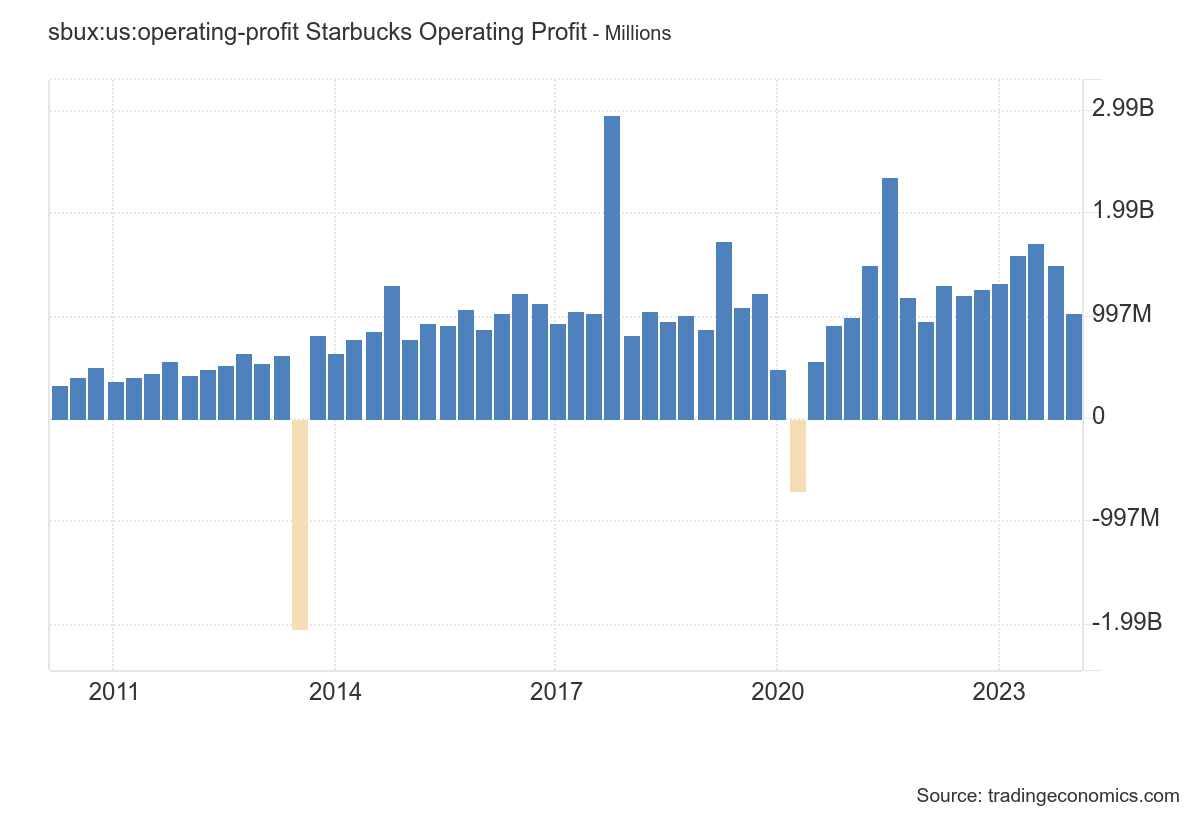
Here are some of their greatest strengths:
Premium Brand and Profitability
Starbucks has established itself as a premium coffeehouse chain. Its high-quality products, environmentally friendly practices, and consistent service across locations allow it to charge premium prices. This has resulted in substantial profits, with annual revenues exceeding $32 billion in 2022, and placing them among the leaders in the coffee industry.
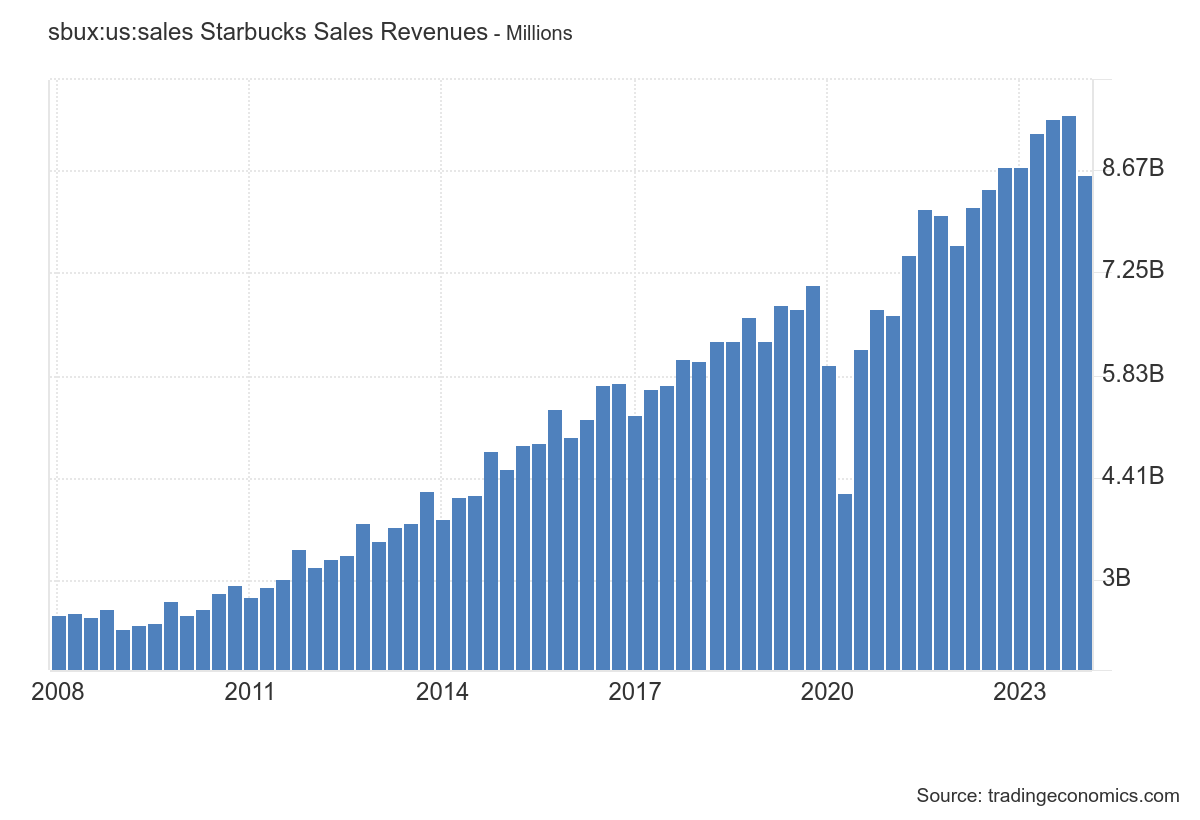
Strategic Reinvestment and Expansion
A significant portion of Starbucks' profits are reinvested into expanding the business. The continuous increase in the number of locations, now over 33,000 worldwide, reflects a well-planned growth strategy that has been highly effective.

Employee Satisfaction
Starbucks is known for treating its employees well, having been listed multiple times on Fortune’s Top 100 Places to Work For. This positive work environment contributes to high employee morale and productivity.
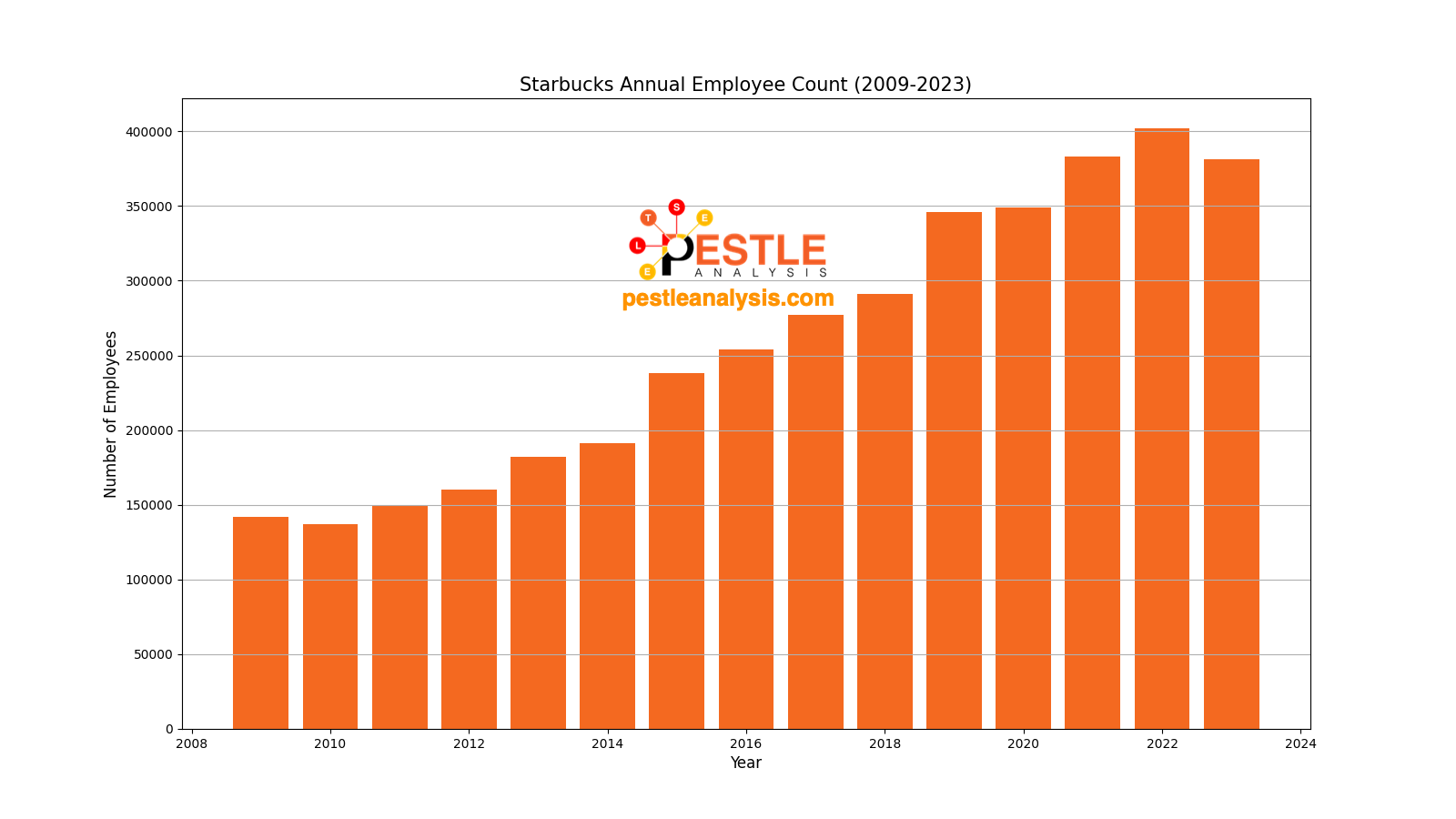
Loyalty Program
Starbucks' loyalty program, Starbucks Rewards, is highly successful and has millions of active members worldwide. This program encourages repeat business by offering rewards, personalized offers, and exclusive perks, fostering customer loyalty and increasing sales.
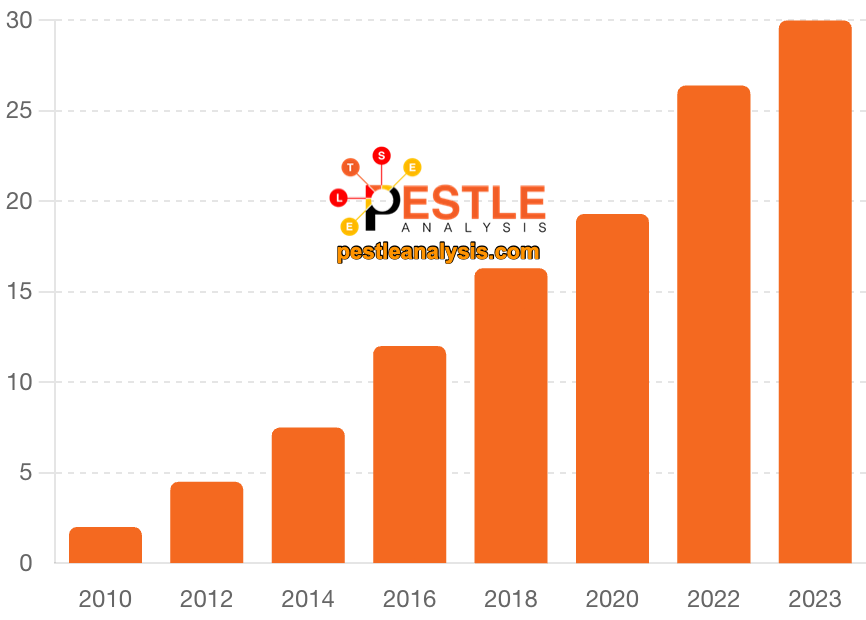
Strong Brand Identity and Marketing
Starbucks has a powerful and recognizable brand image, reinforced through effective marketing strategies and campaigns. The company's iconic logo, consistent store design, and innovative advertising create a strong brand presence that resonates with consumers globally.
Example:
- Starbucks leverages its global network to implement social impact initiatives, such as the “Greener Stores” framework, which aims to design and operate sustainable stores worldwide. As of 2024, Starbucks has certified 6,000 Greener Stores in more than 40 markets globally, strengthening its brand reputation and appeal to socially conscious consumers .
Extensive Global Network of Coffee Shops
Starbucks operates over 37,000 stores worldwide as of 2023. This extensive network not only boosts brand visibility but also facilitates global market penetration and customer accessibility, reinforcing Starbucks’ dominant position in the coffee shop industry.
Example:
- Starbucks has aggressively expanded in China, one of its fastest-growing markets. The company opened its 5,000th store in the country in 2021 and plans to open thousands more by 2025. This extensive network in a key market enhances Starbucks’ global presence and growth prospects
Diversification and Acquisitions
Starbucks has successfully diversified its product offerings beyond coffee to include teas, snacks, and branded merchandise. Additionally, strategic acquisitions, such as Teavana and Evolution Fresh, have expanded its market reach and product portfolio, contributing to overall growth and resilience.
Example:
- In 2005, Starbucks acquired Ethos Water to address global water access issues while enhancing its product line and social responsibility image. Ethos Water donates a portion of its aimed to address global water access issues while enhancing Starbucks’ product line and social responsibility image. Ethos Water donates a portion of proceeds to water, sanitation, and hygiene programs in underserved communities.
Sustainability Initiatives
Starbucks has made significant strides in sustainability, including commitments to ethically sourced coffee, reducing waste, and minimizing environmental impact. These efforts not only appeal to environmentally conscious consumers but also enhance the company's reputation as a responsible and forward-thinking brand.
Example:
- Starbucks is committed to sourcing 100% of its coffee ethically through its Coffee and Farmer Equity (C.A.F.E.) Practices program. Developed in collaboration with Conservation International, this program is a verification system requiring regular reverification of supply chains. Starbucks relies on SCS Global Services to ensure third-party audit integrity, covering economic transparency, social responsibility, environmental leadership, and quality. Starbucks has been committed to this program since 2004, continuously improving auditing standards to support coffee farmers and maintain a sustainable supply.
Starbucks Weaknesses
Like every company, Starbucks does have some weaknesses. The most important are:
High Price Point
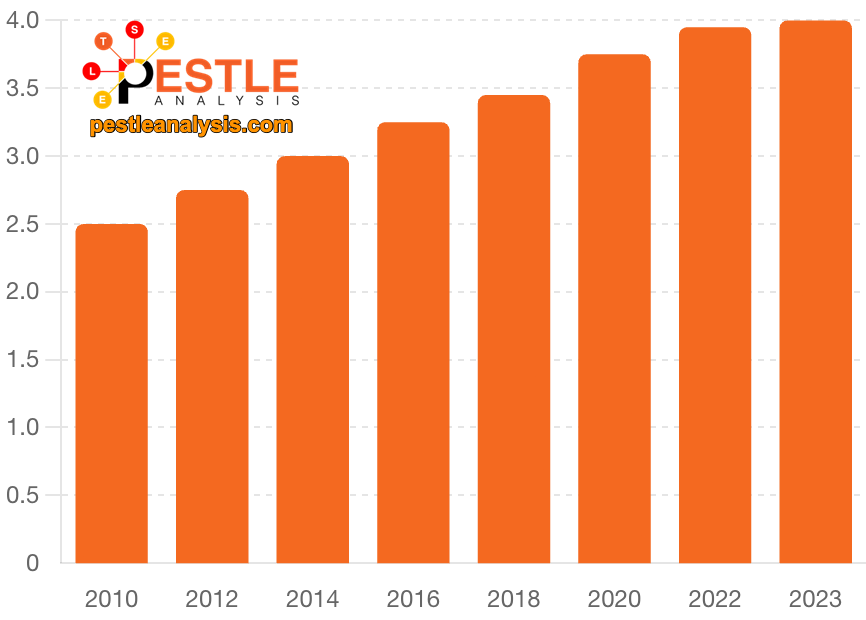
While the premium pricing strategy underscores the brand’s quality, it also limits accessibility.
The hefty price tags on some of their products (starting even with their most basic coffee options) deter plenty of customers who might otherwise make Starbucks a part of their daily lives. While their premium quality and good ethical values might be attractive, some just don’t have that much money to spend on a cup of coffee.
Lack of Unique Products
Despite popular items like frappuccinos and pumpkin spice lattes, Starbucks' product offerings are not significantly unique. Many competitors offer similar products, reducing the distinctiveness of Starbucks’ menu.
Example:
- In 2019, Dunkin’ Donuts introduced their unique “Signature Lattes,” which include distinctive flavors such as “Blueberry Crisp” and “Caramel Craze.” These beverages differentiate Dunkin’s menu by offering flavors and combinations that are not commonly found in Starbucks stores. This type of product innovation can attract customers seeking novel experiences that Starbucks’ more standard menu offerings may not provide.
Dependence on a Single Product Category
Starbucks's majority of revenue comes from coffee. This dependence on a single product category makes the company vulnerable to market fluctuations, changes in consumer preferences, and disruptions in the global supply chain.
High Operational Costs
Operating a large number of stores globally results in significant operational costs, including rent, utilities, and labor. These high costs can impact profitability, especially in regions with expensive real estate and labor markets.
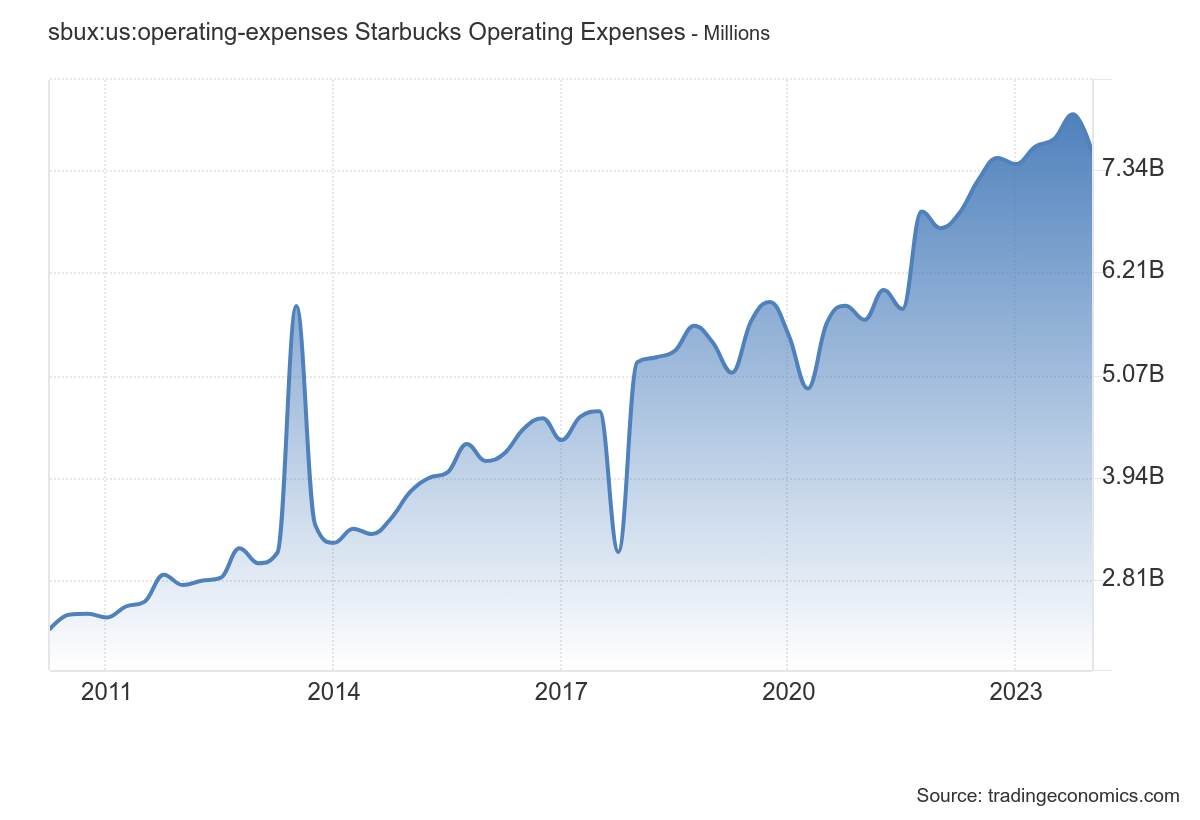
Cultural Differences in Global Markets
Starbucks' standardized menu and store design may not always align with local tastes and cultural preferences in diverse global markets. This can limit the company's ability to fully penetrate and succeed in certain regions, potentially resulting in lower market share and revenue in those areas.
Starbucks Opportunities
This multinational coffee chain does have several opportunities for the future, though, which are as follows:
Global expansion
While Starbucks does have many coffeehouses across the globe, most of them are located within the US. There are plenty of regions where profitably branching out is a possibility, including India, Central Europe, and some regions in Africa. Further international growth can significantly increase its market share.
New Products and Co-Branding
Expanding product lines and co-branding initiatives can open new revenue streams. Selling branded products in supermarkets and collaborating with other major brands could enhance Starbucks' visibility and profitability. Imagine the introduction of Starbucks products in McDonald’s Restaurants (something which will quite possibly never happen)!
Technological Innovations
Starbucks can further leverage technology to enhance customer experience and operational efficiency. Opportunities include expanding mobile ordering and payment options, integrating artificial intelligence for personalized recommendations, and using data analytics to optimize inventory and supply chain management.
Example:
- In 2024, Starbucks can leverage advancements in AI-powered customer service chatbots. These chatbots can be integrated into their mobile app and website to handle customer inquiries, take orders, and provide personalized recommendations based on customer preferences and purchase history. Implementing such AI technology can enhance customer experience, streamline operations, and increase efficiency by reducing wait times and improving order accuracy.
Health and Wellness Trends
With growing consumer interest in health and wellness, Starbucks can introduce and expand its offerings of healthier options. This could include more plant-based beverages, low-calorie snacks, and functional drinks like those infused with vitamins or probiotics to cater to health-conscious customers.
Examples:
- Brands like Blue Bottle Coffee and Dunkin’ have introduced oat milk lattes, which are popular among those looking for dairy-free alternatives. Peet’s Coffee offers almond milk cold brew options, which cater to both vegan customers and those with lactose intolerance.
- Pret A Manger offers low-calorie veggie cups with hummus, providing a healthy and convenient snack option. Starbucks can look at how Panera Bread offers protein-rich snack boxes with items like boiled eggs, nuts, and fruits.
- Competitors like Moon Juice and The Coffee Bean & Tea Leaf offer matcha lattes infused with adaptogens like ashwagandha for stress relief. Many local cafes and chains like Whole Foods have introduced kombucha on tap, which is popular for its probiotic benefits.
Sustainability Leadership
Starbucks has the opportunity to position itself as a leader in sustainability by implementing more ambitious environmental initiatives. This could involve increasing the use of renewable energy in stores, reducing plastic use, expanding the availability of reusable cups, and investing in sustainable farming practices. This can enhance brand loyalty among eco-conscious consumers.
Starbucks Threats
As a company, Starbucks does have a few threats that need addressing if it wants to keep growing and remain the world’s leading coffeehouse chain. They are as follows:
Competition from Cheaper Alternatives
Major competitors like Dunkin’ Donuts and McDonald’s offer similar quality products at lower prices. While these companies don’t pride themselves entirely on their coffees and teas, this fierce competition poses a threat to Starbucks' market share, particularly if consumer preferences shift towards more affordable options.
Market Dependency and Price Volatility
Starbucks' success heavily relies on the popularity of coffee, tea, and convenient snacks. A shift in consumer preferences or significant price increases in coffee, tea, and dairy products could adversely affect the company’s profitability.
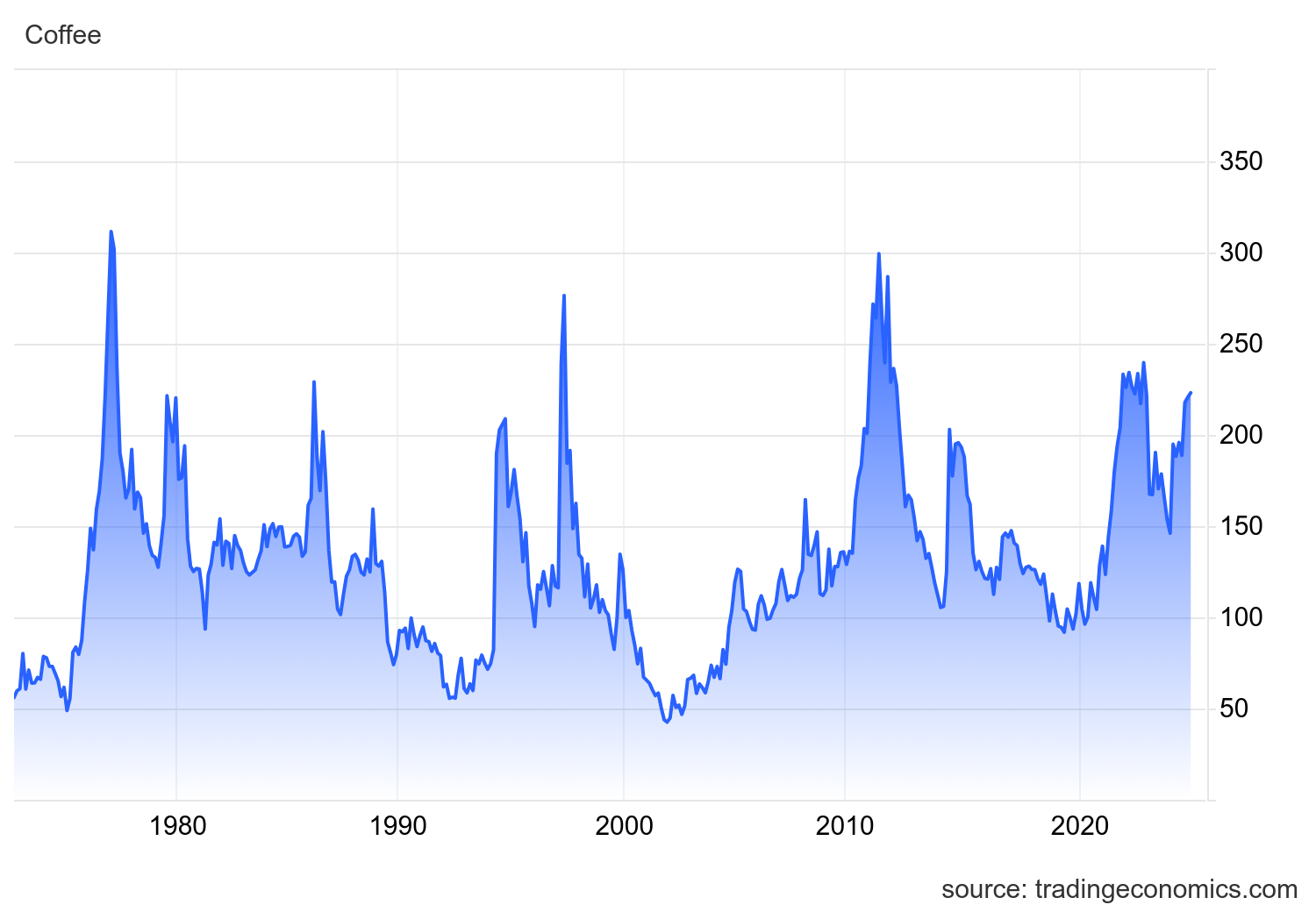
Economic Downturns
Economic instability or recessions can significantly impact consumer spending. During such times, discretionary spending on premium coffee may decline, leading to reduced sales for Starbucks, as customers may opt for cheaper alternatives or cut back on non-essential purchases.
Health Concerns and Changing Preferences
Increasing awareness of health issues related to high sugar and calorie consumption can negatively affect sales of some of Starbucks' popular beverages and snacks. Additionally, shifting consumer preferences towards healthier options or alternative drinks could reduce demand for traditional coffee products.
Supply Chain Disruptions
Starbucks’ extensive reliance on a global supply chain makes it vulnerable to disruptions. Events like natural disasters, geopolitical tensions, and pandemics can significantly impact the availability and cost of key ingredients, leading to potential operational and financial challenges.
Regulatory and Compliance Risks
Starbucks operates in numerous countries, each with its own set of regulations regarding labor, food safety, environmental standards, and corporate governance. Changes in these regulations, stricter enforcement, or new compliance requirements can increase operational costs and complexity, potentially affecting profitability and growth.
Those are all of the major points in this SWOT analysis of Starbucks.
Recommendations Based on Starbucks SWOT Analysis
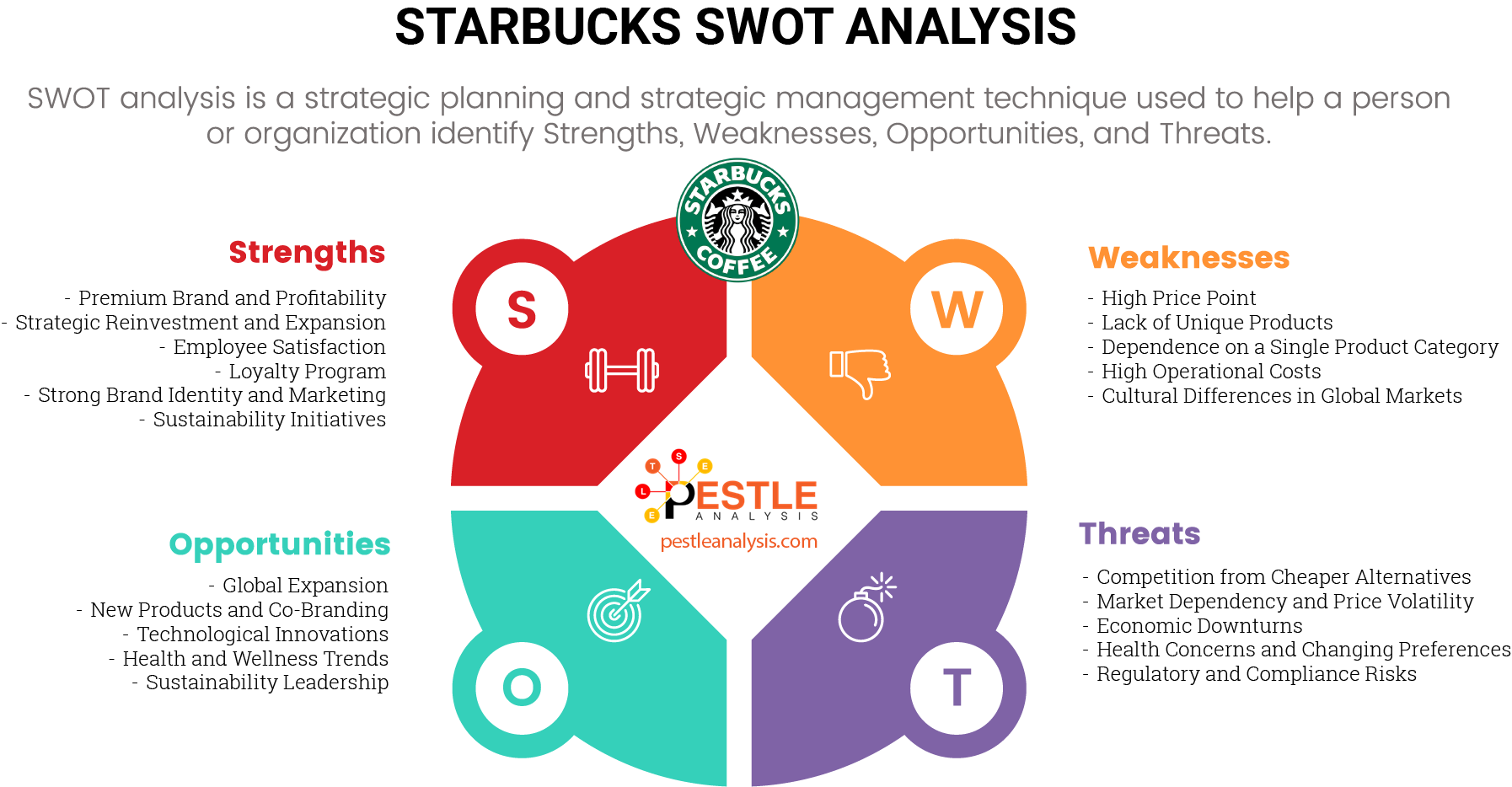
To conclude, if they can play their cards right, this company’s massive brand and large capital should help to carry them through any turbulence that the future might present. As with any company, a clever approach to learning, developing, and evolving should cement its survival.
For now, though, Starbucks has plenty of opportunities to take and a few threats to deal with.
Starbucks' Competitors
However, understanding Starbucks' position in the market is only part of the picture. To gain a comprehensive view of the competitive landscape, it's essential to study the SWOT analyses of Starbucks' key competitors.
- SWOT analysis of Dunkin' Donuts
- SWOT analysis of McDonald's
- SWOT analysis of Costa Coffee
- PESTLE analysis of Subway
- SWOT analysis of Panera Bread
I encourage you to dive deeper into the competitive analysis, exploring how each company positions itself, its market strategies, and how it adapts to industry trends. This broader perspective will enhance your knowledge and strategic thinking, whether you're an investor, a business student, or simply a coffee enthusiast.
Happy researching, and may your journey into the world of coffeehouse competition be as rich and rewarding as a freshly brewed cup of Starbucks coffee!

